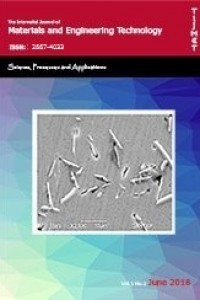EXAMINATION OF THE INFLUENCE OF PRINTING PARAMETERS FOR THE CONTINUOUS CARBON FIBER-REINFORCED THERMOPLASTICS BASED ON FUSED DEPOSITION MODELING
EXAMINATION OF THE INFLUENCE OF PRINTING PARAMETERS FOR THE CONTINUOUS CARBON FIBER-REINFORCED THERMOPLASTICS BASED ON FUSED DEPOSITION MODELING
Additive Manufacturing, Polymer-matrix Composites, Continuous Fiber-reinforced Thermoplastic, Mechanical Properties,
___
- H. Yu, H. Hong, S. Cao, R. Ahmad, Topology optimization for multipatch fused deposition modeling 3D printing, Appl. Sci. 10 , 2020. https://doi.org/10.3390/app10030943.
- R. Rezaie, M. Badrossamay, A. Ghaei, H. Moosavi, Topology optimization for fused deposition modeling process, Procedia CIRP. 6 , 2013 521–526. https://doi.org/10.1016/j.procir.2013.03.098.
- M.R. Karamooz Ravari, M. Kadkhodaei, M. Badrossamay, R. Rezaei, Numerical investigation on mechanical properties of cellular lattice structures fabricated by fused deposition modeling, Int. J. Mech. Sci. 88 , 2014 154–161. https://doi.org/10.1016/j.ijmecsci.2014.08.009.
- R. Gümrük, R.A.W. Mines, Compressive behaviour of stainless steel micro-lattice structures, Int. J. Mech. Sci. 68 , 2013 125–139. https://doi.org/10.1016/j.ijmecsci.2013.01.006.
- M.P. Behera, T. Dougherty, S. Singamneni, Conventional and additive manufacturing with metal matrix composites: A perspective, Procedia Manuf. 30 , 2019 159–166. https://doi.org/10.1016/j.promfg.2019.02.023.
- T. Pereira, J. V. Kennedy, J. Potgieter, A comparison of traditional manufacturing vs additive manufacturing, the best method for the job, Procedia Manuf. 30 , 2019 11–18. https://doi.org/10.1016/j.promfg.2019.02.003.
- A. Gao, F. Zhao, F. Wang, G. Zhang, S. Zhao, J. Cui, Y. Yan, Highly conductive and light-weight acrylonitrile-butadiene-styrene copolymer/reduced graphene nanocomposites with segregated conductive structure, Compos. Part A Appl. Sci. Manuf. 122 , 2019 1–7. https://doi.org/10.1016/j.compositesa.2019.04.019.
- R. Matsuzaki, M. Ueda, M. Namiki, T.K. Jeong, H. Asahara, K. Horiguchi, T. Nakamura, A. Todoroki, Y. Hirano, Three-dimensional printing of continuous-fiber composites by in-nozzle impregnation, Sci. Rep. 6 , 2016 1–7. https://doi.org/10.1038/srep23058.
- P.K. Penumakala, J. Santo, A. Thomas, A critical review on the fused deposition modeling of thermoplastic polymer composites, Compos. Part B Eng. 201 , 2020 108336. https://doi.org/10.1016/j.compositesb.2020.108336.
- N. Krajangsawasdi, L.G. Blok, I. Hamerton, M.L. Longana, B.K.S. Woods, D.S. Ivanov, Fused Deposition Modelling of Fibre Reinforced Polymer Composites: A Parametric Review, J. Compos. Sci. 5 , 2021 29. https://doi.org/10.3390/jcs5010029.
- R. Matsuzaki, M. Ueda, M. Namiki, T.K. Jeong, H. Asahara, K. Horiguchi, T. Nakamura, A. Todoroki, Y. Hirano, Three-dimensional printing of continuous-fiber composites by in-nozzle impregnation, Sci. Rep. 6 , 2016 1–7. https://doi.org/10.1038/srep23058.
- H. Li, T. Wang, S. Joshi, Z. Yu, The quantitative analysis of tensile strength of additively manufactured continuous carbon fiber reinforced polylactic acid (PLA, Rapid Prototyp. J. 25 , 2019 1624–1636. https://doi.org/10.1108/RPJ-01-2018-0005.
- M. Araya-Calvo, I. López-Gómez, N. Chamberlain-Simon, J.L. León-Salazar, T. Guillén-Girón, J.S. Corrales-Cordero, O. Sánchez-Brenes, Evaluation of compressive and flexural properties of continuous fiber fabrication additive manufacturing technology, Addit. Manuf. 22 , 2018 157–164. https://doi.org/10.1016/j.addma.2018.05.007.
- J.M. Chacón, M.A. Caminero, P.J. Núñez, E. García-Plaza, I. García-Moreno, J.M. Reverte, Additive manufacturing of continuous fibre reinforced thermoplastic composites using fused deposition modelling: Effect of process parameters on mechanical properties, Compos. Sci. Technol. 181 , 2019 107688. https://doi.org/10.1016/j.compscitech.2019.107688.
- K. Chen, L. Yu, Y. Cui, M. Jia, K. Pan, Optimization of printing parameters of 3D-printed continuous glass fiber reinforced polylactic acid composites, Thin-Walled Struct. 164 , 2021 107717. https://doi.org/10.1016/j.tws.2021.107717.
- A. Uşun, R. Gümrük, The mechanical performance of the 3D printed composites produced with continuous carbon fiber reinforced filaments obtained via melt impregnation, Addit. Manuf. 46 , 2021. https://doi.org/10.1016/j.addma.2021.102112.
- X. Tian, T. Liu, C. Yang, Q. Wang, D. Li, Interface and performance of 3D printed continuous carbon fiber reinforced PLA composites, Compos. Part A Appl. Sci. Manuf. 88, 2016 198–205. https://doi.org/10.1016/j.compositesa.2016.05.032.
- Yayın Aralığı: Yılda 2 Sayı
- Başlangıç: 2018
- Yayıncı: Necip Fazıl YILMAZ
FABRICATION AND WELDING OF ALUMINUM COMPOSITE
Wafa MELİK, Zakaria BOUMERZOUG, Fabienne DELAUNOİS
Ufuoma UNUEROH, Amos Omoefe EBEBEİNWE
INVESTIGATION OF EFFECT OF PRE-CONSUMER RECYCLING ACRYLIC FIBER RATIO ON YARN AND FABRIC PROPERTIES
Esin SARIOĞLU, Serdar SAYCAN, Perihan TEKİN, Halil İbrahim ÇELİK, Hatice Kübra KAYNAK
Altuğ UŞUN, Recep GÜMRÜK, Nuri YILDIZ, Bahri Barış VATANDAŞ
YARN QUALITY INVESTIGATION OF COMPACT COTTON YARNS WITH DIFFERENT COMBING NOIL PERCENTAGE
Halil İbrahim ÇELİK, Özhan ÇOBAN, Esin SARIOĞLU
Ömer EYERCİOĞLU, Engin TEK, Mehmet ALADAĞ
RESEARCH ON THE ELECTRICAL EFFECT OF FERROMAGNETIC MATERIAL ON THE COIL
Mehmet Ali ÖZÇELİK, Ahmet AYCAN
INVESTIGATION OF THE HEAT AFFECTED ZONE BY THERMAL CYCLE SIMULATION TECHNIQUE
Zakaria BOUMERZOUG, Fabienne DELAUNOİS, Oualid BEZİOU, Ines HAMDİ
A COMPARATIVE STUDY OF BRAKE WEAR PERFORMANCE WITH RECENT COATING METHODS
